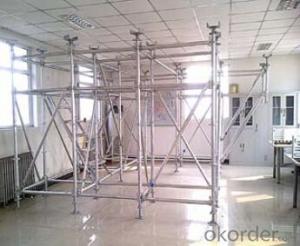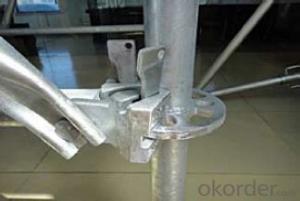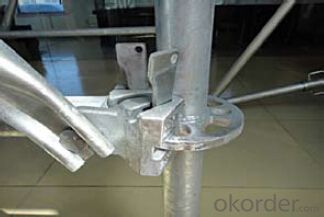Ring-lock Scaffolding accessories for Formwork and Scaffolding System
- Loading Port:
- Tianjin
- Payment Terms:
- TT OR LC
- Min Order Qty:
- 50 m²
- Supply Capability:
- 1000 m²/month
OKorder Service Pledge
Quality Product, Order Online Tracking, Timely Delivery
OKorder Financial Service
Credit Rating, Credit Services, Credit Purchasing
You Might Also Like
Ring-lock Scaffolding
A support system for construction, ownsadvantages of both cup-lock scaffolding andshoring tower.
It is in the development direction of new typescaffolding.
It is widely used in buildings, bridges, tunnels etc..
Characteristics:
◆ Easy to storage and transportation
◆ High degree of standardization
◆ Easy and quick erection
◆ Excellent stability and bearing capacity
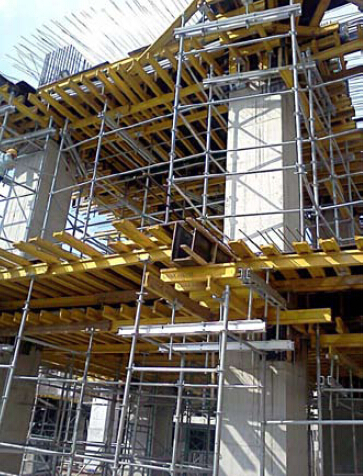
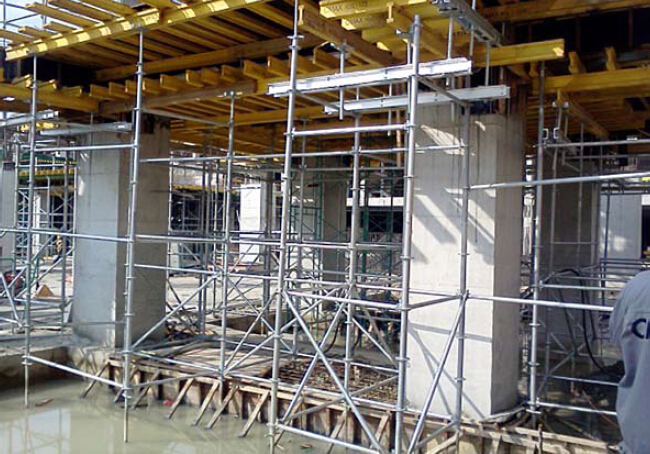
- Q: Can steel formwork be used in areas with extreme temperature variations?
- Yes, steel formwork can be used in areas with extreme temperature variations. Steel is known for its durability and strength, which allows it to withstand various temperature conditions. However, it is important to consider potential expansion and contraction of the steel due to temperature changes, and take appropriate measures to prevent any negative effects on the formwork structure.
- Q: How does steel formwork affect the overall sound insulation of the structure?
- The overall sound insulation of a structure is not directly influenced by steel formwork. The main purpose of steel formwork is to temporarily support and shape the concrete during construction. It is commonly used for concrete walls, slabs, columns, and beams. The sound insulation of a structure primarily depends on the materials used for walls, floors, and ceilings, as well as the design and construction techniques employed. These factors play a significant role in the transmission of sound waves and the overall acoustic performance of the building. Although steel formwork itself does not possess inherent sound insulation properties, it can indirectly impact the sound insulation of a structure during the construction phase. Improper installation or inadequate securing of the formwork may result in gaps or cracks in the concrete, which can compromise the sound insulation performance of the finished structure. However, it is essential to note that any potential impact on the sound insulation of the structure caused by steel formwork is temporary and can be resolved in subsequent stages of construction. This can be achieved by incorporating suitable acoustic insulation materials or employing soundproofing techniques. In conclusion, steel formwork does not directly affect the overall sound insulation of a structure. The sound insulation of a building is primarily determined by the materials and construction techniques utilized for walls, floors, and ceilings. Proper installation and subsequent measures can address any temporary impact on sound insulation caused by steel formwork during the construction process.
- Q: Can steel formwork be used for architectural concrete slabs with embedded elements?
- Certainly, architectural concrete slabs with embedded elements can indeed make use of steel formwork. The utilization of steel formwork facilitates the pouring and shaping of concrete, as it furnishes a robust and long-lasting framework. This framework enables the precise and accurate positioning of embedded components, encompassing pipes, electrical conduits, and reinforcement bars. Additionally, steel formwork boasts the benefit of being reusable, rendering it an economically viable option for construction ventures. Furthermore, thanks to the sleek surface offered by steel formwork, the end result is a superbly refined finish for architectural concrete slabs.
- Q: What are the different types of steel alloys used in formwork manufacturing?
- There are several types of steel alloys that are commonly used in formwork manufacturing due to their specific properties and characteristics. These alloys include: 1. Mild Steel: Mild steel, also known as low carbon steel, is a popular choice for formwork manufacturing due to its affordability and versatility. It has a relatively low amount of carbon and is easy to work with, making it suitable for various formwork applications. 2. High-strength Steel: High-strength steel alloys, such as high-strength low-alloy (HSLA) steel, are known for their increased strength and durability. These alloys have higher levels of carbon and other alloying elements, making them ideal for formwork that requires high load-bearing capacity and resistance to deformation. 3. Stainless Steel: Stainless steel is widely used in formwork manufacturing due to its excellent corrosion resistance properties. This alloy contains a minimum of 10.5% chromium, which forms a thin protective layer on its surface, preventing rust and corrosion. Stainless steel is particularly suitable for formwork used in marine or highly corrosive environments. 4. Tool Steel: Tool steel is a type of high-carbon alloy steel that is specifically designed for tool and die applications. It offers excellent hardness, wear resistance, and toughness, making it suitable for formwork manufacturing where a high level of precision and durability is required. 5. Alloy Steel: Alloy steel is a broad category that includes various types of steel alloys with specific properties tailored for different applications. These alloys are made by adding elements such as chromium, nickel, molybdenum, or tungsten to improve their strength, hardness, and corrosion resistance. Alloy steel can be used in formwork manufacturing that requires specific mechanical properties. Overall, the choice of steel alloy for formwork manufacturing depends on the specific requirements of the project, including load-bearing capacity, corrosion resistance, durability, and cost-effectiveness.
- Q: What are the different types of edge protections available for steel formwork?
- There are several types of edge protections available for steel formwork, each serving a specific purpose and providing different levels of safety and functionality. Some of the common types include: 1. Steel edge protection: This type of edge protection is made of steel and is typically used in heavy-duty construction projects. It provides excellent durability and strength, ensuring the safety of workers and preventing accidental falls. 2. Rubber edge protection: Rubber edge protection is a flexible and lightweight option that offers impact resistance and a cushioning effect. It is commonly used in areas where workers may come into contact with the edge, such as staircases or walkways. 3. Plastic edge protection: Plastic edge protection is lightweight, easy to install, and cost-effective. It provides a barrier between workers and the edge, preventing accidental slips or falls. Plastic edge protection is commonly used in low-risk areas or temporary construction sites. 4. Foam edge protection: Foam edge protection is made of soft and flexible material, providing a cushioning effect and preventing injury if someone accidentally bumps into it. It is typically used in areas where there is less risk of falls but a higher chance of impact. 5. Metal edge protection: Metal edge protection is commonly used in industrial settings where heavy machinery or equipment may come into contact with the edge. It offers excellent durability and protection against impact, ensuring the safety of both workers and equipment. 6. Removable edge protection: This type of edge protection can be easily installed and removed when no longer needed. It is commonly used in areas where temporary edge protection is required, such as during construction or renovation projects. It is essential to choose the appropriate type of edge protection based on the specific requirements of the construction project, considering factors such as the level of risk, durability, ease of installation, and cost-effectiveness.
- Q: How does steel formwork contribute to the overall stability of a structure?
- Steel formwork is a crucial component in the construction industry that greatly contributes to the overall stability of a structure. It is widely used in the casting of concrete elements such as walls, slabs, columns, and beams. One of the primary ways that steel formwork enhances stability is by providing a rigid and robust framework for the pouring and setting of concrete. The steel panels and frames are designed to withstand the pressure exerted by the wet concrete, ensuring that it retains its shape and does not deform during the curing process. This helps to prevent any potential structural deficiencies or unevenness that may compromise the stability of the final structure. Furthermore, steel formwork offers exceptional strength and durability, making it suitable for various construction projects. The high tensile strength of steel allows it to withstand heavy loads, which is particularly important in the construction of large-scale structures with significant weight-bearing requirements. This strength also ensures that the formwork can be reused multiple times, reducing the overall construction costs and environmental impact. Additionally, steel formwork provides excellent dimensional stability, meaning it maintains its shape and dimensions throughout the construction process. This characteristic is crucial in ensuring the accuracy and consistency of the structure, as any deviations or variations in shape may result in structural instability. Moreover, steel formwork is highly resistant to moisture and other environmental factors, which can be detrimental to the stability of a structure. Its corrosion-resistant properties make it suitable for use in outdoor construction sites, where exposure to rain, humidity, and other elements may occur. This resistance to corrosion ensures that the formwork remains intact and does not weaken over time, thereby contributing to the long-term stability of the structure. In conclusion, steel formwork plays a vital role in enhancing the overall stability of a structure. Its rigid and robust framework, combined with its strength, durability, dimensional stability, and resistance to environmental factors, ensures that the concrete is properly formed and retains its structural integrity. By providing a stable and secure foundation for the construction process, steel formwork significantly contributes to the stability and safety of the final structure.
- Q: How does steel formwork affect the overall weight of the structure?
- The overall weight of a structure can be significantly influenced by steel formwork. In comparison to traditional timber formwork, steel formwork is generally heavier due to the inherent properties of steel. Steel, being denser and heavier than wood, means that the contribution of steel formwork to the total weight of the structure is greater. Nevertheless, in certain situations, the weight of the steel formwork can also have advantages. The added weight of steel formwork can provide stability and rigidity to the structure during construction, ensuring proper support and shaping of the concrete. This can result in a more precise and long-lasting final structure. Furthermore, steel formwork is typically more durable and can be reused multiple times, unlike timber formwork which often needs replacement after a few uses. This can lead to reduced environmental impact and cost savings in the long term, despite the initial increase in weight caused by steel formwork. Ultimately, the impact of steel formwork on the overall weight of a structure depends on several factors such as project size, complexity, design requirements, and chosen construction method. However, it is crucial to consider the trade-offs between formwork weight and its benefits in terms of stability, durability, and cost-effectiveness.
- Q: How does steel formwork affect the overall construction site waste recycling?
- The overall waste recycling at a construction site can be greatly influenced by steel formwork. In contrast to traditional timber formwork, steel formwork is more long-lasting and can be reused multiple times. This results in a decrease in waste production at the construction site since there is less necessity for the production and disposal of new formwork materials. Furthermore, cleaning and maintaining steel formwork is simpler, which extends its lifespan and reduces the need for replacement. This not only decreases waste but also saves costs associated with purchasing new formwork materials for each construction project. Moreover, steel formwork is highly recyclable. Once its life cycle is complete, it can be recycled and utilized to manufacture new steel products, diminishing the demand for fresh materials and reducing the environmental impact. Through the utilization of steel formwork, construction sites can greatly diminish their waste generation and contribute to a more sustainable construction industry. This not only benefits the environment but also promotes a more efficient and cost-effective approach to construction.
- Q: How does steel formwork contribute to the overall accuracy of concrete placement?
- Steel formwork contributes to the overall accuracy of concrete placement by providing a sturdy and rigid structure that ensures precise and consistent dimensions of the concrete elements. It helps in maintaining the desired shape, level, and alignment of the concrete, resulting in a uniform and smooth finish. The strength and stability of steel formwork prevent any deformation or movement during the pouring and curing process, which is crucial for achieving accurate and reliable concrete placement.
- Q: Can steel formwork be used for both flat and sloped concrete surfaces?
- Yes, steel formwork can be used for both flat and sloped concrete surfaces. Steel formwork is highly versatile and can be easily adjusted and shaped to accommodate different angles and slopes during the concrete pouring process. Its strength and rigidity make it suitable for supporting the weight and pressure of the concrete, ensuring a smooth and uniform finish regardless of the surface inclination.
Send your message to us
Ring-lock Scaffolding accessories for Formwork and Scaffolding System
- Loading Port:
- Tianjin
- Payment Terms:
- TT OR LC
- Min Order Qty:
- 50 m²
- Supply Capability:
- 1000 m²/month
OKorder Service Pledge
Quality Product, Order Online Tracking, Timely Delivery
OKorder Financial Service
Credit Rating, Credit Services, Credit Purchasing
Similar products
Hot products
Hot Searches
Related keywords
